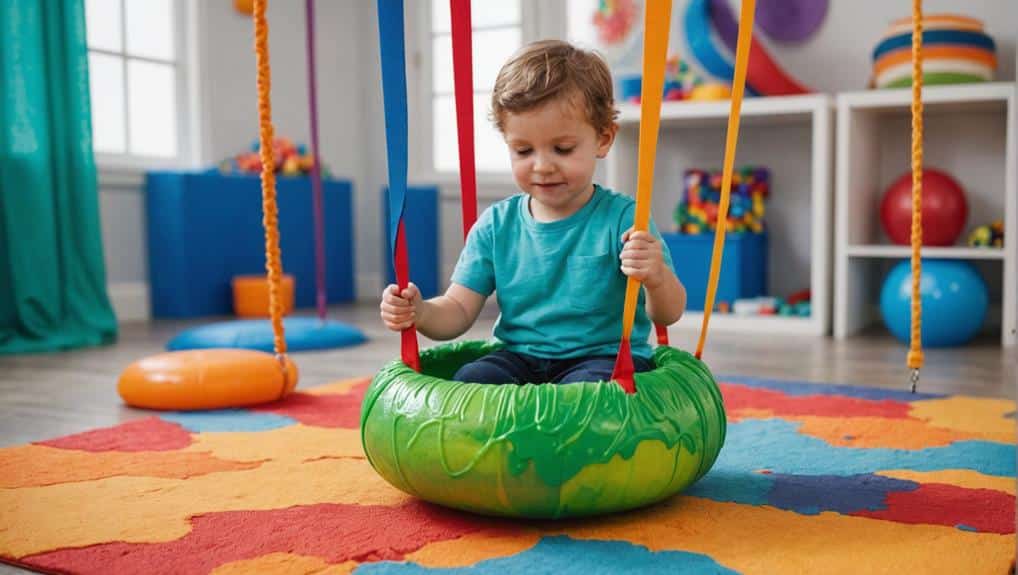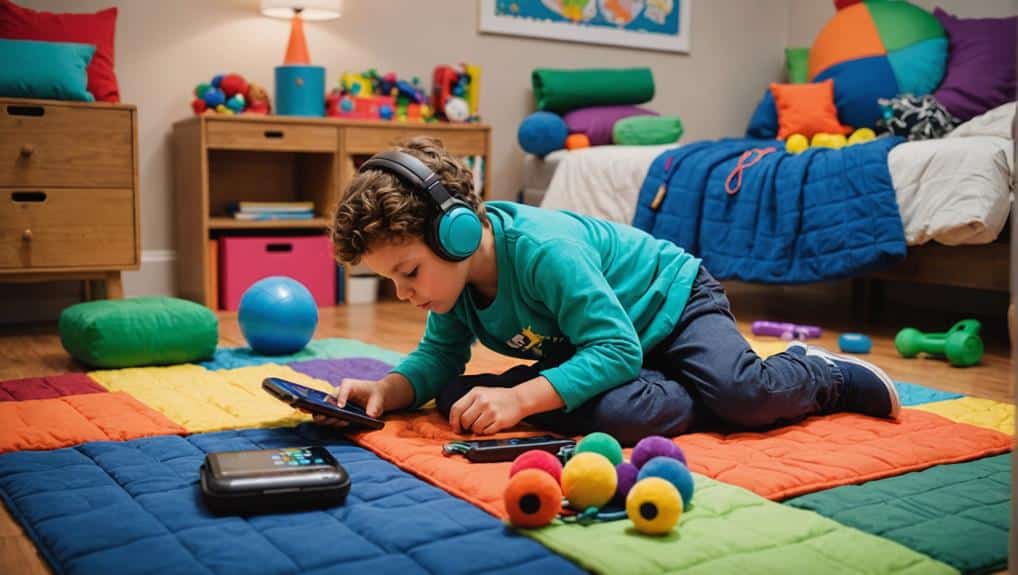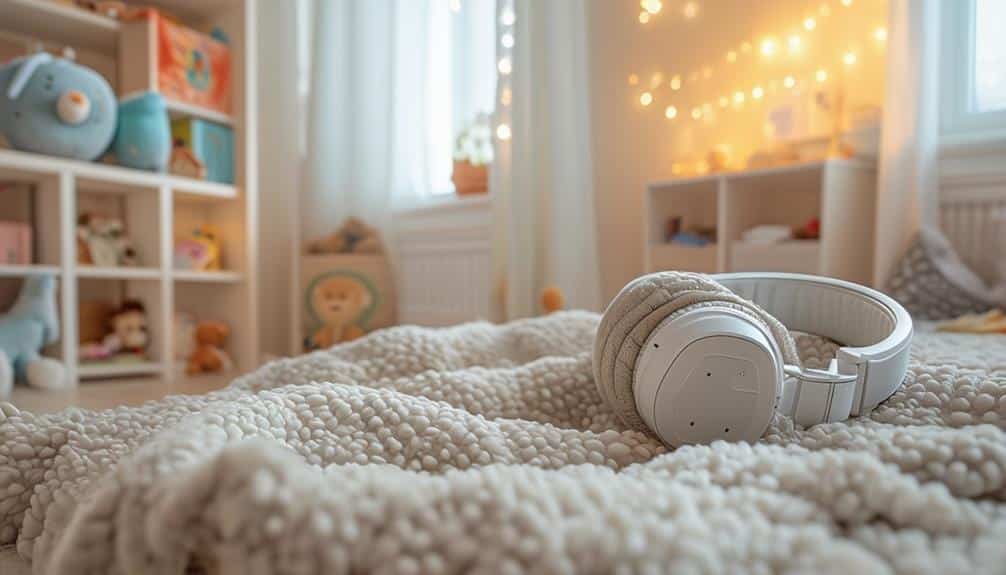Exploring the world of Sensory Processing Disorder (SPD) as a parent can often feel demanding and overpowering. A deep understanding of the disorder and the child’s distinct needs is essential to creating a conducive environment for children with SPD. A sensory-safe environment reduces SPD’s daily challenges and dramatically improves the child’s overall growth. While eliminating distractions and providing customized sensory experiences are crucial, what other strategies can parents use to create such a space? Let’s delve into this further.
Key Takeaways
- Create a calm area, using soft lighting and cozy seating to help regulate sensory input.
- Provide various sensory experiences, such as sensory bins or a sensory garden, catering to different needs.
- Use visual schedules and timers to aid in routine management and transitions.
- Implement sensory-friendly lighting and decor to minimize sensory overload.
- Involve the child in setting up their sensory-friendly space, promoting ownership and independence.
Parenting Tips for Sensory Processing Disorder
In pediatric health, Sensory Processing Disorder (SPD) represents a complex condition where the brain finds difficulty managing sensory stimuli, affecting a child’s everyday functionality. This disorder leads to significant sensory problems in children, impacting their behavior, learning, and social interactions. Therapy for SPD focuses on sensory experiences to help regulate these sensory inputs and improve social skills. Research has shown that up to 93% of individuals diagnosed with autism also exhibit symptoms of SPD, underscoring a potent association between the two conditions.
Children with SPD may show an over or under-sensitivity to different senses, which shapes their responses to environmental stimuli. For instance, some children may shy away from bright lights or loud noises (over-sensitivity), while others might not respond to sensations like touch or temperature (under-sensitivity). Engaging these children in tailored sensory activities, as therapists do, can boost their ability to process sensory information effectively. These sensory disparities can create challenges, including difficulties with social interaction and disrupted sleep patterns.
The impact of SPD on a child’s life can be profound, necessitating a thorough understanding of the disorder to provide the best support. Through awareness and empathy, we can help children navigate their distinct sensory landscapes and foster their ability to engage with the world around them successfully.
Designing Sensory Spaces at Home
Creating a sensory-friendly space at home can significantly improve children’s daily experiences with Sensory Processing Disorder (SPD). One primary strategy is designating a calm area equipped with soft lighting and cozy seating to help children regulate their sensory input.
Integrating elements of occupational therapy, such as sensory integration therapy, can further enrich the effectiveness of this space. This therapy aims to help children manage their sensory challenges by exposing them to sensory stimulation in a structured, repetitive manner.
Customization is critical when creating a sensory space. It’s worth involving the child in this process to cater to their sensory needs and preferences. Sensory bins filled with different textures can provide tactile stimulation, promoting the development of fine motor skills.
Weighted blankets are a notable addition to this space. They offer deep pressure input that has a calming effect. These are especially beneficial for children with SPD, as they help manage sensory processing difficulties.
Apart from indoor spaces, consider creating a sensory garden. This outdoor exploration area, rich in diverse textures and scents, provides a variety of sensory experiences. This approach aligns with creating sensory-friendly environments, which can notably improve a child’s ability to process sensory information.
Incorporating Sensory Activities and Therapy

Incorporating sensory activities and therapy into a child’s daily routine enhances their sensory experiences and fosters self-regulation. Activities like obstacle courses, swings, and sensory toys like fidget spinners and stress balls can significantly improve sensory regulation and engagement. These activities form part of the tailored interventions recommended by pediatric occupational therapists, explicitly designed to address sensory integration challenges in children.
Visual supports, including schedules and timers, aid in routine management and ease shifts, creating a sense of predictability and stability for the child. Whether through white noise machines or calming music, sound therapy can make a peaceful sensory space that minimizes sensory overload and promotes relaxation.
Involving children in designing their sensory space, selecting their preferred sensory toys, or choosing their calming music fosters a sense of independence. This involvement also encourages them to take ownership of their sensory experiences, pivotal in developing self-regulation skills.
Empowering Children With SPD
While it may seem challenging at the outset, enabling children with Sensory Processing Disorder (SPD) can be achieved through a series of thoughtful and child-centric interventions. Encouraging children with SPD begins with fostering sensory space ownership. Please include them in designing their environment to cater to their sensory needs. This could mean creating customized sensory bins filled with materials that provide tactile stimulation, promoting calming engagement.
These sensory bins can be particularly beneficial for children showing signs of SPD hypersensitivity or hyposensitivity to sensory stimuli. They offer a controlled and safe environment for the children to investigate and interact with different textures, helping them better understand and manage their sensory responses.
Weighted blankets and vests are valuable tools in this exploration. They offer security and grounding, helping children feel safe and centered in their bodies. This feeling of security is crucial to their self-confidence and independence.
Outdoor sensory discovery, such as a sensory garden, can be incredibly enriching. The varied stimuli they encounter outdoors can help them navigate and understand their sensory responses better. Meanwhile, sensory toys such as chewable jewelry and textured toys provide oral and tactile sensory input, contributing to a complete sensory diet.
Enhancing Child Development Through Sensory-Friendly Environments

Enabling children with Sensory Processing Disorder (SPD) extends beyond the limits of sensory tools and toys, reaching into sensory-friendly environments. These environments, often facilitated by pediatric occupational therapists (OTs), support child development by providing customized spaces that promote a child’s ability to thrive and develop crucial skills.
Consider integrating elements like weighted blankets and sensory bins in your sensory-friendly setting. Weighted blankets offer deep touch pressure stimulation, fostering tranquility and sensory regulation. Sensory bins encourage hands-on exploration, stimulating a child’s tactile senses and promoting cognitive development.
It’s also valuable to explore the role of specialized gear, a vital component of sensory therapy, in establishing a sensory-friendly environment. This equipment targets specific sensory systems, further aiding the child’s sensory regulation.
Physical activity breaks and sensory playthings can benefit children with SPD, enhancing balance, coordination, and involvement. Regular physical activity breaks enable children to release pent-up energy and refocus, while sensory playthings provide captivating, multi-sensory experiences.
Visual aids and sound therapy can enrich routine management and establish a soothing ambiance. Visual schedules, for instance, can assist children in comprehending and adhering to daily routines, while sound therapy can lessen auditory sensitivity.
Involve your child in designing their sensory area, fostering independence and self-regulation. This process empowers the child and guarantees the environment is tailored to their needs.
Frequently Asked Questions
What Type of Professional Can Diagnose Sensory Processing Disorder in Children?
Sensory Processing Disorder (SPD) in children is typically diagnosed by trained professionals, such as pediatricians, pediatric occupational therapists, and psychologists, who have expert knowledge in evaluating and understanding sensory-related behaviors and challenges.
How Can I Explain SPD to My Child’s Teacher and Peers at School?
Explaining SPD to your child’s teacher and peers involves articulating your child’s distinct sensory experiences, likening it to wearing glasses that adjust one’s perception, and stressing its impact on daily activities and interactions.
Are There Specific Diets Recommended for Children With Sensory Processing Disorder?
While there’s no specific diet universally recommended for children with Sensory Processing Disorder, unique dietary adjustments may help manage specific symptoms. Consultation with a registered dietitian or healthcare provider is crucial for customized dietary guidance.
Can a Child With SPD Also Have Other Conditions Like Autism or ADHD?
Yes, a child with Sensory Processing Disorder (SPD) can also have other conditions like Autism or ADHD. These conditions often coexist, presenting a complex tapestry of symptoms that require thorough understanding and personalized therapeutic approaches.
What Are Some Online Resources or Support Groups for Parents of Children With SPD?
Numerous online resources exist for parents of SPD children, including the STAR Institute for SPD and the Sensory Processing Disorder Parent Support Group. These platforms offer valuable insights, advice, and community support.
Conclusion
To wrap up, establishing sensory-friendly settings for children with Sensory Processing Disorder can be a foundation for their cognitive and heartfelt growth. As a haven of calmness, such areas can act as a refuge amidst the sensory challenges these children frequently encounter. By carefully planning and executing, these sanctuaries can assist children in navigating their sensory terrains, enabling them to engage more comfortably with the environment, thus nurturing their general health and development.


Recent Comments